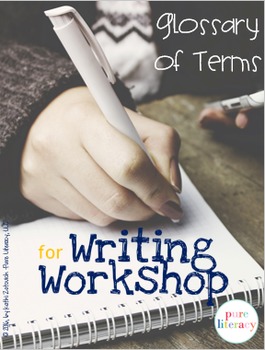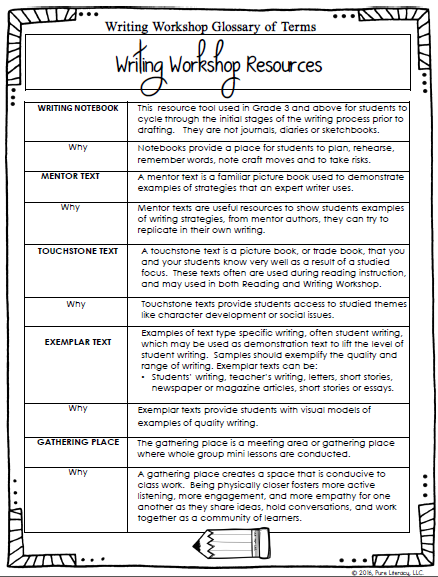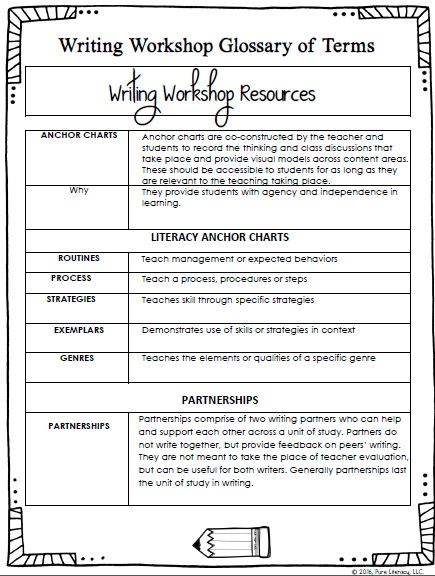Just dropping by with my fourth post in the continuing series about terms frequently used in Writing Workshop with my own definitions. This post is dedicated to untangling terms associated with procedures and strategies in Writing Workshop. It’s all about the 12 Most Common Writing Workshop Procedures and Strategies.
I’ve consulted with several teachers who are new to Writing Workshop and new to implementing the Lucy Calkins writing curriculum. Recently, I’ve been getting some questions from teachers, both on the blog and also in the field, about how to implement Writing Workshop as an instructional practice in their schools and districts.
Personally, I think one of the most powerful things teachers can do when implementing a Writing Workshop model or a writing curriculum is to establish the habit of coming together as a school community to study the qualities of student writing and to regularly meet and discuss what’s working and what’s not. What strategies they see students transferring to their independent work and what’s not taking hold. What practices teachers are implementing and what’s just beyond their reach.
I encourage you to embrace being a part of a learning and growing community and to carve out time to meet routinely with your grade level teams, school teams or as an organization to have honest conversations about your instructional practice. I hope this Glossary of Terms will help your teams develop a common understanding around terms and boost your confidence when sharing your practice with others.
As always here's my spoiler alert: these are not official “researched-based” definitions nor did they come from some literacy search engine data base. And honestly, there are probably others who may use these words entirely differently. But these are the words I find myself using frequently during Workshop instruction based on my own experience as a teacher, coach, consultant, staff developer and author.
Twelve Common Writing Workshop Procedures and Instructional Strategies
On-Demand Writing:
What: A writing assessment given to students prior to starting a unit of study in the Writing Units of Study Curriculum by Lucy Calkins. This assessment reveals what students may already know about a particular type of writing prior to instruction.
Why: Provides evidence from authentic work to establish instructional course and target needs for further differentiation.
Bend:
What: In the Writing Units of Study Curriculum by Lucy Calkins and her colleagues at the Reading and Writing Project, the parts, or sections, in a unit of study are referred to as “bends.” The Bends in the Road are the skills you plan to teach in a Unit of Study. This term originates from the work of Lucy Calkins and colleagues at the Reading and Writing Project. Lucy suggests to think of the unit of study as a teaching journey. And like all journeys, you may take temporary detours or changes in directions. For example, you shift your teaching focus from organization and structure to teaching elaboration strategies about including details and examples. You’re not completely getting off course and ending the unit, just taking a little strategic detour or bend in the road.
Why: Instructional strategy .
Bootcamp:
What: Short focused instruction and practice on a specific skill or strategy. Generally, boot camps take place at the end of a unit when post assessments reveal a review is needed of a specific skill or strategy. For example, a convention boot camp will focus on punctuation and mechanics.
Why: Instructional strategy.
Status of the Class:
What: This term originates from the work of Nancie Atwell. Before releasing students from the gathering place, the teacher will ask each student to name what they are going to be working on in Writing Workshop that day.
Why: Goal setting and focus writing.
Writing in the Air:
What: Writing in the air is a planning strategy. Sometimes you might teach students to plan by orally rehearsing (practicing out loud) what you want to write and pretend write it in the air during the active engagement portion of the mini lesson.
Why: A quick and effective technique to demonstrate your own writing.
Seed Ideas in Primary Grades:
What: This term originals from the original Units of Study for Primary Writing by Lucy Calkins and Colleagues. When writing a personal narrative, a seed idea is a small moment, or event that took place only a small part of one day. Seed ideas are narrowly focused and generally easier to write about in detail.
Why: Planning strategy.
Watermelon Ideas vs Seed Ideas in Primary Grades:
What: Using the analogy to a watermelon. This is a topic or an idea that is very broad. It generally stretches across many days, a week or two. It often results in summarizing rather than storytelling. Primary students are encouraged to narrow their storytelling focus and to capture the smaller event or seed idea. Watermelon and seed ideas were included in the original Units of Study for Primary Writing by Lucy Calkins and Colleagues.
Why: Planning strategy.
Story Mountain or Story Arc:
What: Using the analogy to a mountain. A story mountain or story arc is a planning tool (graphic organizer) to help intermediate grade writers develop suspense. Fiction writers write stories to tell how problems were solved. Using the story mountain or story arc, writers develop the plot and action through plotting out across the arc small events that build to the eventual problem solving event.
Why: Planning strategy.
The Heart of the Story:
What: Writer uses internal thinking by including internal dialogue, facial expressions, and gestures to reveal the significance of the event.
Why: Elaboration strategy.
Show, Don’t Tell:
What: Writer uses action, dialogue, details, internal thinking, or gestures, to help the reader visualize what’s happening in the story.
Why: Elaboration strategy.
Flash Drafts in Intermediate Grades:
What: Term to describe drafts that intermediate grade level students (Grades 3 and about) write “fast and furiously” during one workshop period. Builds to stamina and volume of writing. Writers work to get all their thoughts down on the paper applying all they know about a specific genre when drafting.
Why: Drafting strategy.
Boxes and Bullets in Intermediate Grades:
What: An outlining method for essay writing. The main idea (or topic) is written in the box and the subtopics are bulleted below.
Why: Planning strategy.
And there you have it, the 12 Most Common Writing Workshop Procedures and Strategies! Do you have any other tips for implementing the Writing Workshop Model of instruction? If so please share, I’d love to hear how your school is implementing the Writing Workshop Model. Share in the comment section here or write in at the Ask Anything section in the sidebar!
Now, I really hope this April series of little posts has been helping to untangle some Writing Workshop terms. My goal is that this April series serves as a little Writing Workshop lingo go-to for you! In saying that, if there is anything I haven't touched upon in this series or that you have questions about please share in the comments section below, the ask anything section in the side bar, or email through your questions. I'm here to answer them all!
Lastly, in the hopes that this series serves as a little lingo go-to I've combined all the posts from this series into a freebie glossary available on my TpT store! For my complete Writing Workshop Glossary of Terms Freebie please visit my Pure Literacy Teachers Pay Teachers site.
Tune in next week for answers to your questions and the final wrap up discussion on the April Writing Workshop Glossary of Terms Series!
Happy Reading!




